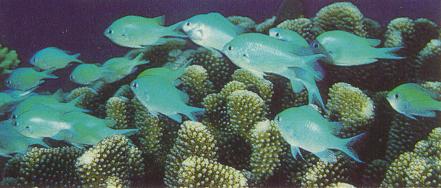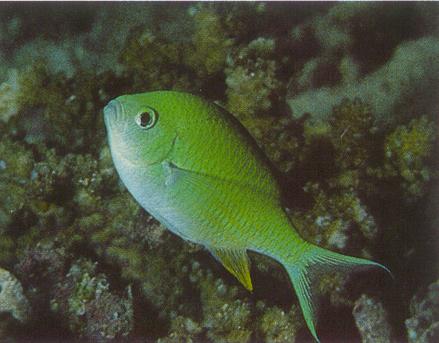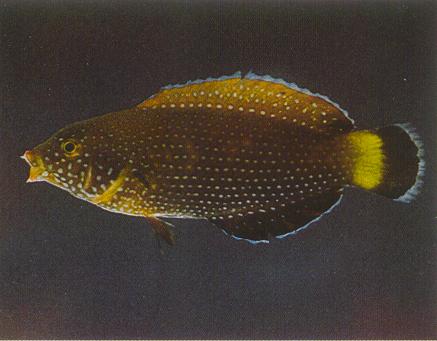
Reef Fishes & Corals, East Coast of Southern Africa by Dennis King. 1996, first edition, Struik Publishers, 128 pages, 294 colour photographs, ISBN: 1868259811. Available at local bookstores or through the Ichthos shop (R 90.94 for ICHTHOS members; R 101.04 for non-members).

This beautiful guidebook is the best book on the market for identifying the common coral-reef fishes and corals of KwaZulu-Natal and Mozambique. Intended for use by divers and snorkellers, the book includes excellent colour photos of some 243 fish species that are often seen on the reefs of this region. The attractive layout comprises a plate of six photographs with a facing page of text that gives information on the family and species represented in the photos. The English name and scientific name are given for each species, but it would have also been useful to give the name of the author and date for each species in the blank space after each species name. The author and date of species names may be necessary for finding additional information about a particular species.
The text for most species is very
brief and includes the maximum size for the species, a colour description
or diagnostic colour features, comments on habitat and depth range, food,
whether the species occurs singly or in shoals, and occasionally some remarks
on behaviour. The absence of distributional information for most
species is unfortunate, particularly as this is important for fish identification,
and on many pages there is plenty of space that could have been used for
this information.
For some fishes that show marked
sexual dichromatism (sexes coloured differently) there are photos of both
sexes, and the juvenile and adult colour patterns are illustrated for some
species that exhibit colour changes with growth.
A couple of minor criticisms: In the Introduction (page 10), it is stated that raggedtooth sharks “retain the embryos in egg sacs in the bodies until the young are born alive”. It is true that raggies are viviparous (give birth), but the developing pups are retained in the oviducts (or uterus) – not “egg sacs” – until ready for birth.
The drawings illustrating the external features of fishes and the pictorial guide to families are inferior. The Zambezi shark is missing its second dorsal fin. The drawings of the coachman and Moorish idol are so diagrammatic that they are misleading (the Moorish idol looks like a boxfish [ostraciid] with long fins). The goldie seems to have swapped pectoral fins with a coelacanth!
A few minor corrections and recent name changes:
The photo of the “redspot (pink ear) emperor, Lethrinus lentjan” is actually the spotcheek emperor, Lethrinus rubrioperculatus Sato 1978; L. lentjan has a marginal red stripe on the gill cover (rather than a red spot), and it usually has a red streak on the base of the pectoral fin.
The photo of the orbicular batfish, Platax orbicularis, is the longfin batfish, Platax teira (Forsskål, 1775); the orbicular batfish does not have the black blotch on the belly at the bottom of the dark bar behind the head.
Spadefish, Tripterodon orbis, attain 75 cm; and the maximum size for spotted hawkfish is 95 mm (not cm).
Adults of both moonies (Monodactylus argenteus and M. falciformis) may have the anterior lobes of the dorsal and anal fins dusky. For the dusky sweeper, it is the base of the anal fin that is dark, not the “margin” of the fin.
The photo of the “blue puller, Chromis viridis” appears to be the black-axil Chromis (C.atripectoralis Welander & Schultz, 1951), as the inner side of the pectoral fin base is black, the diagnostic feature distinguishing atripectoralis (below left) from the very similar viridis (below right).


The comment on p. 74 that the juveniles and females of the bluespotted tamarin (Anampses caeruleopunctatus) often “appear to have a broad pale yellow band at the base of tail” is probably based on sightings of the yellowband tamarin, Anampses melanurus Bleeker, 1857.

Yellowband tamarin, Anampses melanurus, 6 cm female, collected at Landers’ Reef off Park Rynie .
The African coris (formerly Coris gaimard africana is
now Coris cuvieri (Bennett, 1831). Coris gaimard occurs
in the eastern Indian Ocean and the western Pacific Ocean.
The photo of the “horned blenny,
Parablennius
cornutus”, is actually the horned rockskipper, Antennablennius bifilum
(Günther 1861).
The valid name for the whitespotted
goby, Bathygobius albopunctatus, is Bathygobius coalitus
(Bennett 1831).
The above criticisms are minor blemishes
on an excellent book. The pictures speak for themselves and range
from excellent to beautiful. Well done Dennis!